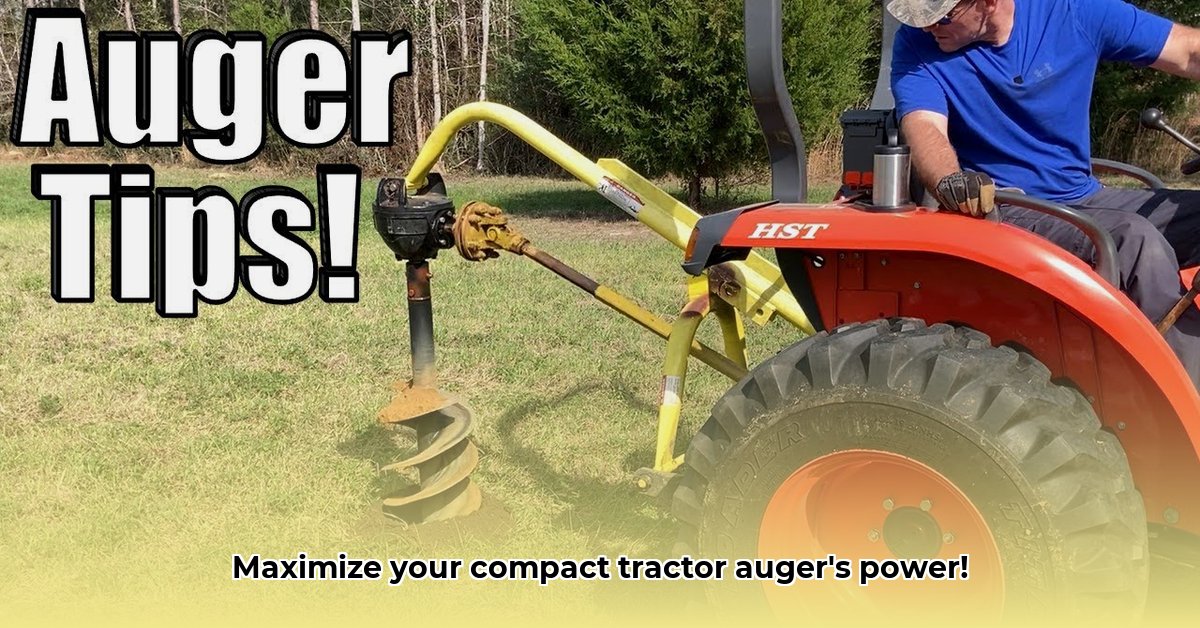
Compact Tractor Auger: Your Guide to Efficient and Sustainable Farming
Choosing the right compact tractor auger is crucial for efficient and sustainable farming practices. This guide provides a step-by-step approach to selecting, using, and maintaining your auger, maximizing its effectiveness and minimizing environmental impact. Proper auger use significantly impacts soil health and overall farming efficiency, ultimately leading to increased yields and reduced resource consumption. For more information on auger selection, check out this helpful resource: Tractor Augers.
Picking the Perfect Auger: Size Matters (And So Does the Soil!)
Auger selection depends heavily on the task and soil conditions. A larger diameter auger (e.g., 10 inches) is ideal for larger projects or dense soil types (like clay), offering greater stability and faster digging. However, this may require more powerful equipment. Conversely, smaller augers (e.g., 6 inches) are suitable for smaller tasks or loose soil, offering better maneuverability. The material also matters; hardened steel augers are more durable for challenging conditions compared to standard steel. Do you need to dig deep holes for fence posts or plant trees? The right auger size and material directly influence the efficiency and success of your project.
Mastering Your Compact Tractor Auger: A Step-by-Step Approach
Effective auger operation requires a systematic approach. Follow these steps for optimal performance and longevity of your equipment.
Pre-Flight Check (Safety First!): Inspect the auger for damage, ensure the PTO (power take-off) shaft is securely connected, and verify the tractor's PTO is correctly engaged. This crucial step prevents accidents and ensures smooth operation.
Hitching Up (Secure Attachment): Carefully attach the auger to your tractor's three-point hitch, following your owner's manual precisely. Proper alignment and secure fastening with hitch pins are vital for safety and efficient operation.
Knowing Your Soil (Adapting to Conditions): Assess soil density and composition. Hard, rocky soil may require pre-drilling or a specialized auger bit capable of handling tough conditions. Ignoring soil conditions may damage the auger or result in inefficient operation.
Digging Smart, Not Hard (Consistent Speed): Maintain a steady speed during operation. Avoid forcing the auger; let it work efficiently. Forcing the auger can lead to damage. Consistent speed optimizes performance and reduces equipment wear.
Depth Perception (Precise Control): Utilize adjustable depth settings for precise hole depth control, especially crucial for tree planting or fence post installation. Accurate depth minimizes rework and maximizes efficiency.
Post-Dig Clean-Up (Preventative Maintenance): Thoroughly clean the auger after use, removing soil and debris. Lubricate moving parts as specified by the manufacturer and store the auger in a dry place to prevent rust and corrosion. Regular cleaning and lubrication significantly extend the auger's lifespan.
Optimizing Your Auger for Sustainable Farming
Sustainable farming practices emphasize soil health and resource conservation. Using your compact tractor auger efficiently plays a significant role in these efforts.
Minimizing Soil Compaction: Aggressive digging can compact the soil, harming plant roots. Choosing the right size and material, using appropriate speeds, and preparing the soil effectively helps mitigate compaction.
Auger Selection Impacts Sustainability: The choices of diameter and material significantly affect soil compaction. A smaller, appropriately chosen auger can be more sustainable than a larger, more aggressive one in many circumstances.
Precision Planting (Enhanced Accuracy): Combining GPS technology with your auger results in improved planting accuracy, minimizing wasted resources and effort.
Troubleshooting Common Auger Issues
Even with proper care, problems can arise. This table highlights common issues, their causes, and solutions.
| Problem | Possible Causes | Solutions |
|---|---|---|
| Auger Won't Turn | PTO not engaged, worn components, obstructions | Check PTO engagement, inspect for damage or wear, remove any obstructions. |
| Uneven Holes | Dull auger bit, uneven soil conditions | Sharpen or replace the bit, adjust digging technique. |
| Auger Binding | Rocks, roots, hard soil, auger too small for soil conditions | Remove obstructions, use a heavier-duty auger or a larger diameter auger. |
The Future of Compact Tractor Augers
The market for compact tractor augers is expanding as farmers seek efficient and earth-friendly solutions. "Ongoing research and development will likely lead to more durable materials and innovative designs, ultimately improving auger performance and soil health," says Dr. Emily Carter, Agricultural Engineering Professor at Purdue University. Expect advancements in augers with integrated technology for even greater precision and effectiveness.
How to Choose the Right Auger Size for Deep Post Hole Digging in Various Soil Types
Auger size selection is critical for successful deep post-hole digging. Soil type is paramount; dense, rocky soil necessitates a larger, more robust auger than loose, sandy soil. An 8-inch auger might suffice for 4x4 posts in easy soil, but denser soil usually requires a 10-inch or larger auger for stability and easier operation. Always ensure your tractor has adequate power for the chosen auger size.
Key Takeaways:
- Proper auger selection is critical for efficient and effective post-hole digging.
- Soil type strongly influences the appropriate auger size and diameter.
- Larger augers offer stability and ease of use in challenging conditions but demand more powerful equipment.
- Safety and equipment compatibility are paramount when selecting and using an auger.